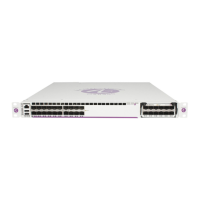Overview of Buffer Pools on 7210 SAS-E and 7210 SAS-D
Page 2 7210 SAS D, E, K OS Quality of Service Guide
Overview of Buffer Pools on 7210 SAS-E and 7210 SAS-D
Default buffer pool exists (logically) at each port. Buffer pools cannot be created or deleted in the
7210 SAS. The egress buffer pools are distributed as access uplink egress buffer pool for access-
uplink ports and access egress buffer pool for access ports. Based on the maximum number of
ports to be supported for access and access-uplink, the total buffer is distributed into the access
egress buffer pool and the access uplink egress buffer pool. The distribution of the buffers into
access and access-uplink egress pools take care of the buffer requirements at the port level for
various queue shaping/ scheduling mechanisms and for various packet sizes varying from 64 bytes
to jumbo frames. Each port on the system gets an equal portion of the available buffers. From the
buffers allocated to a port, each queue gets its CBS amount of buffers. The remaining buffers are
allocated towards the shared MBS pool per port. All the queues of the port can use the buffers
from the shared MBS pool. By default, each queue on the access port and access-uplink port is
associated with slope-policy default which disables the high-slope, low-slope and non-TCP slope
parameters within the pool.
On 7210 SAS-E, SRED is supported to evaluate the packet’s eligibility to be allocated a buffer
based on the slope parameters configured for the queue.
On 7210 SAS-D, WRED is supported to evaluate the packet’s eligibility to be allocated a buffer
based on the slope parameters configured for the queue.
Configuration Guidelines for 7210 SAS-D
7210 SAS-D provides an option to use either 2 slope per queue or 3 slopes per queue. This can be
configured using the CLI command config>system>qos> no use-wred-slopes. The option to use
only 2 WRED slopes per queue (port egress queues), allows differentiating in-profile and out-of-
profile traffic flows. The option to use 3 WRED slopes per queues allows differentiating in-profile
TCP traffic, out-of-profile TCP traffic and non-TCP traffic (both in and out-profile use a single
slope). The slope does not get enabled by default. In order to maintain backward compatibility, by
default the system uses 3 slopes option and user has to change it explicitly to use 2 slopes (if they
desire).
The following table compares the WRED slope used for different traffic flows with 2 slopes or 3
slopes per queue.

